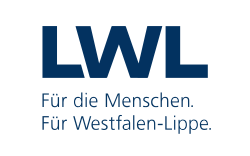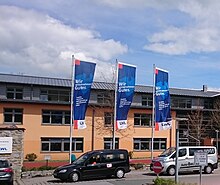Moritz von Büren School
| Moritz von Büren School | |
|---|---|

|
|
| type of school | special school |
| founding | 1830 |
| address |
Bahnhofstrasse 12 |
| place | Büren |
| country | North Rhine-Westphalia |
| Country | Germany |
| Coordinates | 51 ° 33 '24 " N , 8 ° 33' 34" E |
| carrier | Regional Association of Westphalia-Lippe |
| student | 107 (April 16, 2015) |
| Teachers | 40 (April 16, 2015) |
| Website | lwl.org/LWL/Jugend/WSGS_Bueren |
The Moritz von Büren School in the East Westphalian town of Büren in North Rhine-Westphalia is a special needs school of the Regional Association of Westphalia-Lippe with a focus on hearing and communication. The former provincial deaf-mute institution in Büren received its current school name in 2006 when it moved into the new building.
history
Today's special needs school was founded on August 1, 1830 by order of the President of the Province of Westphalia, Ludwig von Vincke , under the name Provinzial-Taubstummenanstalt zu Büren, making it one of the oldest schools for the hearing impaired in German-speaking countries. The management of the school, which looked after six students when it was founded and whose class was in the Catholic teachers 'seminar in Büren, was initially taken over by the head of the teachers' seminar in Büren, seminar director Klocke, who was replaced by the seminar director Köchling the following year. The seminar director represented the school externally, conducted the official correspondence, identified the nursing homes in which the students were housed while attending school, and concluded the relevant care contracts. The technical director of the school was the deaf and dumb teacher Wirsel. He gave lessons, prepared annual reports and introduced the participants of the teachers' seminar theoretically and practically to the teaching of deaf students. The school was financed by the Westphalian Provincial Deaf-Mute Fund. The main task of the office for the deaf and dumb in Büren was initially to enable future elementary school teachers to teach deaf pupils together with so-called "wholehearted" pupils. Efforts to transfer deaf-mute lessons to primary school lessons proved futile and were discontinued in the following years.
The growing number of pupils, which had already risen to 19 in 1834, made it necessary to hire an assistant teacher. In 1847, the provincial school council in Münster set up a second assistant teaching position, as the number of students had now risen to 49. The second assistant teacher position was held by the school authority candidate Josef Dornseifer. Despite the growing number of students, there were still only two classrooms available. This state of affairs was warned several times by the provincial school council, so that in 1868 the Büren institution for the deaf and dumb finally separated from the teachers' seminar and moved to a nearby building with four classrooms and a service apartment for the main teacher. In 1869, after Wirsel's death, the position of technical manager was taken over by the previous second teacher, Dornseifer. Furthermore, in the fall of 1869 the school moved from the seminar building to a nearby building that now comprised three classrooms. In the following year, the relationship between the seminar director and the technical director of the school, who was now given the title “Head”, was reorganized. The seminar director retained the overall supervision of the school and remained subordinate to the headmaster, but from then on the headmaster took over the entire school management .
In 1876 the school passed from the administration of the state authorities to the sponsorship of the provincial association . A uniform curriculum for the school was introduced in 1887. After the previous headmaster Dornseifer retired on October 1, 1889, Ferdinand Derigs succeeded him on November 1, 1889. In the period from 1876 to 1891 the school for the deaf and dumb in Büren trained a total of 543 students.
In 1895 the school moved to a new building on Bertholdstrasse, which now made it possible to accommodate eight classes. At that time the school was attended by 59 students who were taught in six classes by seven teachers. With the coming into force of the "Law [es] concerning the schooling of blind and deaf and dumb children", the number of pupils and teachers rose sharply from 1911, so that six years later the school had 14 classes, 17 teachers and 150 pupils. Although the institutions for the deaf and dumb had already been renamed to schools for the deaf in 1938, the use of the terms “deaf” and “school for the deaf” did not gain acceptance until after 1945.
From September to November 1944 the Wehrmacht confiscated the main school building on Bertholdstrasse, so that the 10 classes taught by the 7 remaining teachers had to move to the opposite one. On January 21, 1949, a vocational class for deaf apprentices was set up at the Froebel School in Bielefeld, which was supervised by the Büren School for the Deaf. The senior teachers Schabedoth and Schepers shared the lessons of the six vocational students. Early intervention for hearing-impaired children was introduced in Büren at the beginning of the 1960s. In 1969 a special kindergarten opened at the school under the sponsorship of the Caritas Association, which included 12 home and three day places. By the beginning of the 1990s, the number of students at the Büren School for the Deaf had fallen to almost 30. Against this background, the school for the deaf and the school for the hard of hearing in Bielefeld formed a school association in 1996 in order to maintain both school locations. The school was called "Westphalian School for the Deaf and Hard of Hearing Bielefeld / Büren". While the special kindergarten had to be closed at the end of the 1990s for financial reasons, the school locations Bielefeld and Büren were able to become independent again in 2002, as the number of pupils had risen continuously since 1996 due to the admission of hard of hearing pupils. In 2005 the school looked after 85 pupils at the school location in Büren, 20 pupils in common lessons at mainstream schools and 50 children as part of pre-school early intervention. In 2006 we moved into a new school building, in which an advice center for hearing-impaired children has now been set up. The Moritz von Büren School Counseling Center has been coordinating and organizing early support for preschool children with hearing impairments since then. She works with regular kindergartens, doctors, clinics, acousticians, other schools and advice centers. Since the 2010/2011 school year, it has also been possible to set up a special-needs kindergarten for hearing-impaired children at the school.
principal
| Years | Seminar directors |
|---|---|
| 1830-1831 | Mr. Klocke |
| 1831-approx. 1869 | Mr. Köchling |
| Years | Technical leaders and directors |
|---|---|
| 1830-1869 | Mr. Wirsel |
| 1869-1889 | Mr. Dornseifer |
| 1889-1921 | Ferdinand Derigs |
| 1921-1923 | Mr. Michels |
| 1923-1933 | Franz Kruse |
| 1933-1948 | Heinrich Alt |
| 1948-1955 | Erich Krömer |
| 1955-1964 | Hans Herbrich |
| 1964-1968 | Heinrich Schepers |
| 1969-1982 | Friedrich Sieren |
| 1982-1996 | Dieter Schnell |
| 1996-to-date | Josef Köjer |
Origin of name
The name change of the former Westphalian School for Deaf Büren associated with the new building of the school in 2006 is due on the one hand to the close connection and cooperation between the school and the city of Büren, but also to the inherited property of the nobleman and baron Moritz von Büren the Jesuit Order , which with these means founded the Büren Teachers' College , in which the first class of the Provincial Deaf-Mute Institute in Büren was established. These funds still exist today in the form of the "Haus Büren'schen Fonds", a special fund of the state of North Rhine-Westphalia.
Educational offer
- Advice center for hearing-impaired children
-
Early intervention
- Early intervention is interwoven with the advice center and offers parents the opportunity to support hearing-impaired children of preschool age at home or in kindergarten
-
Special school kindergarten
- For hearing-impaired children from 3 years up to school entry
-
primary school
- The primary level comprises 5 school years (including entry class) and is based on the educational program of a regular primary school
-
Hauptschule (secondary level I)
- The main school branch includes grades 5–10. Student. Possible school qualifications are:
- Graduation or leaving certificate according to class 9 of the special school with the special focus "learning"
- Graduation certificate according to class 10 of the special school with the special focus "learning"
- Graduation or leaving certificate after class 9 of the secondary school
- Graduation certificate according to grade 10 of the secondary school, type A or type B
literature
- Ferdinand Derigs: The provincial deaf-and-dumb institution in Büren . Büren 1905, p. 53 .
- Adolf Rodewyk: nobleman and baron Moritz von Büren SJ; Festschrift for the 350th birthday . Paderborn 1954, p. 83 .
- 165 years of school for the deaf in Büren . Association of Friends and Supporters of the Westphalian School for the Deaf e. V., Büren 1995, pp. 14-16.
- LWL-Archivamt für Westfalen , Archiv LWL, Best. 556/1304 (new school building), 1251 (school situation in World War II and in the reconstruction phase after 1945)


